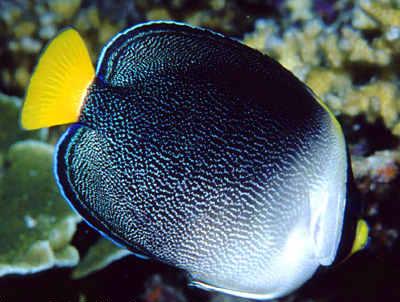Angelfish - Vermiculated
Singapore Angelfish Scientific Name: Chaetodontoplus mesoleucus
Mon, 28th April, 2025 - 9:23 am GMT
Sponsor Ads:

Alternative Name
Singapore Angelfish Scientific Name: Chaetodontoplus mesoleucusBasic Info
A mature Vermiculated Angel is up to seven inches (18 centimeters) long. The frontal parts of the face, and the fan shaped tail are both yellow. Behind the yellow section of the face is a thick black vertical band. Apart from some yellow edging present on or near the edge of the dorsal fin, the rest of the Vermiculated Angel is whitish gray. This color darkens into a grayish black at the rear of the body, and the anal fin, as well as the upper part of the body and the rear area of the dorsal fin, are often entirely black.
Health
A single, smaller, Vermiculated Angel should have an aquarium with at least 30 gallons of volume. Temperatures should remain between 72 and 78 degrees Fahrenheit (23 to 26 degrees Celsius), with a pH value of 8.3 or 8.4. Specific gravities between 1.020 and 1.025 are recommended. The part of this range below 1.023 would be appropriate for a fish-only enclosure, though aquariums containing invertebrates should have salinities above 1.023 in order to keep those residents healthy. Vermiculated Angels may nip at hard corals, soft corals, and tridacnid clams. They should not be kept with other fish of similar species or other Vermiculated Angels. The most important part of a Vermiculated Angel's diet is variety.Habitat
Saltwater fish - Wild Vermiculated Angels normally live in reefs associated with continental shelves. They are found at depths between three and 66 feet (one and 20 meters).Behavior
The Vermiculated Angel looks much like a Butterfly Fish and is sometimes called the Red Sea Butterfly Fish; however, this lovely fish is a true Angel. The Vermiculated Angel can be a beautiful, rewarding captive for marine hobbyists. These fish feed on tunicates, sponges, and algae. Captive fish should have varied diets to ensure they receive proper nutrition. It is important to keep them in well established tanks, since tiny organisms or algae gleaned from live rock often makes up an important portion of their diets. Vermiculated Angels should also have plenty of hiding places in their aquariums. In an aquarium environment, the Vermiculated Angel may attack other Vermiculated Angels or other fish similar to its species. They have been known to nip at hard and soft corals and tridacnid clams. They are not normally considered to be reef safe but are sometime kept in miniature reef aquariums.Origin
Indo-PacificHistory
Most Vermiculated Angels in the pet trade are collected from the Indo-Pacific and the Indian Ocean. They are, in fact, found throughout much of the Indo Pacific region, including the Solomon Islands, Papua New Guinea, Taiwan, Indonesia, the Philippine Islands, New Caledonia, Palau, Micronesia, Japan, and Malaysia.Common Foods
These fish are commonly offered sponges, mysid shrimp and other crustaceans, worms, spirulina, and algae.Sponsor Ads:
"We cannot enter into alliances until we are acquainted with the designs of our neighbors." -- Sun Tzu, The Art of War
Angelfish - Vermiculated
Coded by: BGID® | ALL RIGHTS RESERVED Copyright © 2000-2025
Disclaimer | Privacy | Report Errors / Contact | Credits
















